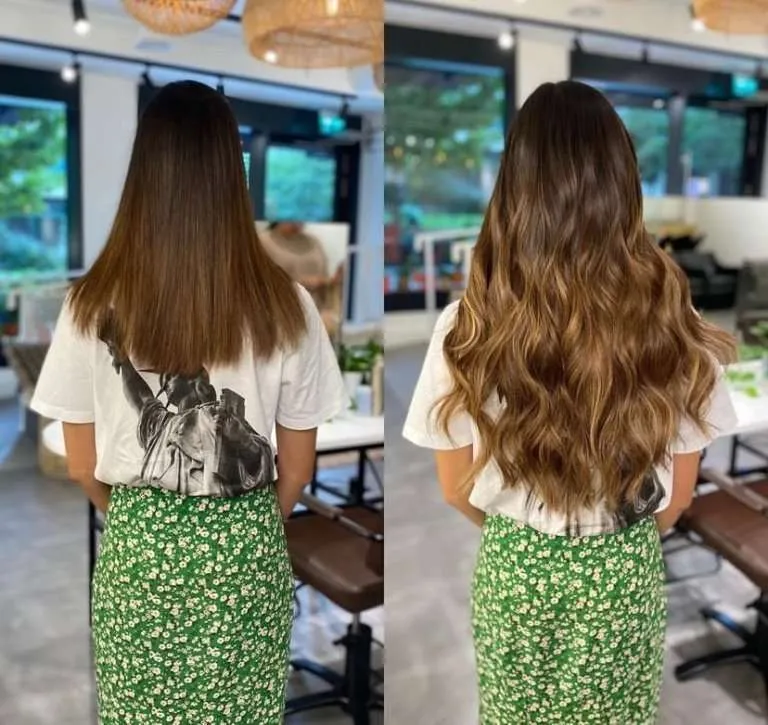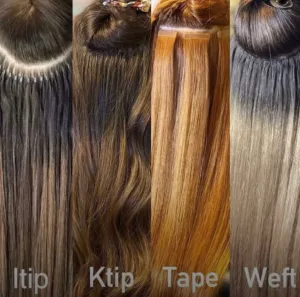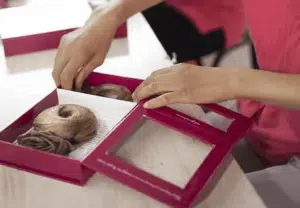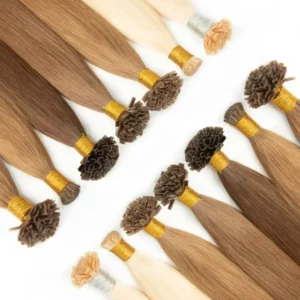Clients want discreet volume that holds up to daily life. Slips, sticky tape, or bulky beads hurt trust. U need a clean, durable system that installs precisely and stays invisible.
K Tip hair extensions are individual keratin-bonded strands fused to small sections of natural hair using heat. They are discreet, customizable, long-wearing, and ideal for active clients when installed and maintained by trained professionals. This guide covers installation, pros and cons, care, and salon-ready comparisons.

U want certainty before adding any new method to your menu. Read on. I will explain the method in plain steps, flag the risks, and share factory-backed tips so U deliver predictable results at scale.
What Are K Tip Hair Extensions?
Confusion around terms slows decisions. Some say K Tip, some say U tip. The core is the same: a keratin bond that melts, shapes, and locks in clean.
K Tip (also called Keratin tip) are pre-bonded strands with a small keratin tip. A stylist melts the tip and molds it around the client’s hair for a flat, secure bond. The method is discreet, customizable, and long-wearing with proper care.

Clear definition
K Tip hair extensions are single strands of human hair. Each strand carries a small pre-formed keratin tip. The tip is often U-shaped. Heat softens the tip. The stylist wraps and presses it around a tiny section of natural hair. The bond cools and hardens in seconds. The result is a compact, flat bond that hides well in most densities.
Why stylists pick this format
The system works well when U want precision. U place bonds where U need volume or length. U can mix shades, lengths, and densities strand by strand. U can fill sides without overloading the crown. U can lift face-framing areas with lighter grams and keep nape areas stronger.
Material notes from a factory point of view
The tip uses keratin. The quality of keratin matters. A clean, cosmetic-grade keratin flows at a stable temperature and cools without brittle edges. The hair quality matters more. Full cuticle hair resists tangling and holds shine. It tolerates heat styling better over time. It also allows re-tipping after removal if the hair remains healthy.
Quick spec snapshot
| Component | Typical spec | Why it matters |
|---|---|---|
| Bond material | Cosmetic-grade keratin | Flows clean, forms flat, reduces white residue |
| Strand weight | 0.5–1.0 g | Matching density to section prevents traction |
| Hair quality | Full cuticle, single-donor | Longevity, polish, reusability |
| Bond shape | U, flat, or nail tip | Ergonomics and bond footprint |

How do K Tip extensions work?
Methods feel risky until U see the steps. A clear workflow reduces re-dos and returns. The process is simple with the right tools and pacing.
Section cleanly. Pick strand weight to match the client’s density. Soften the keratin tip with a fusion tool. Wrap and press around a small hair section. Roll or clamp flat. Repeat in bricklay pattern, then blend and finish.
Tools and setup
U need a temperature-controlled fusion iron or a clean fusion heater, protective finger guards, sectioning clips, a fine comb, tail comb, heat shield, and small silicone pads. U also need alcohol wipes and bond de-stick solution for quick cleanup. Keep a color ring and multiple gram weights ready.
Sectioning and strand mapping
Start with a clean, dry scalp and hair. Avoid heavy oils before install. Map rows in a bricklay pattern. Keep perimeter and part lines free for concealment. Adjust rows to avoid pressure points. Use thinner strands for finer zones. Use normal strands for denser back areas. Do not overload one area.
Heat, wrap, and set
Set the tool to the manufacturer’s recommended range. Do not guess. Soften the tip, not the client’s hair. Place the tip slightly below the root to allow free rotation. Wrap the soft keratin around the natural hair section. Press evenly. Roll gently to form a smooth cylinder or clamp flat with shielded pliers. Let it cool fully before tug testing.
Finishing and blending
After each row, do a light tug test. Remove any bond that slips and redo it with a fresh tip. After full install, cut and blend. Use minimal heat styling on day one. Advise the client to keep bonds dry for 48 hours so keratin sets.
| Step | Goal | Common mistake | Fix |
|---|---|---|---|
| Mapping | Even weight | Rows too close to part | Shift rows, use bricklay |
| Melting | Clean flow | Overheating keratin | Lower temp, shorter dwell |
| Molding | Flat bond | Bulky or sharp edges | Roll evenly, trim flash |
| Finish | Natural blend | Over-thinning | Blend in stages, check movement |
K Tip hair extensions pros and cons?
Every method trades something. U need an honest list. That list helps U match clients to the right system and stop buyer’s remorse.
Pros: discreet bonds, custom placement, strong wear, water- and workout-friendly.
Cons: heat tool needed, time-intensive install, bond-by-bond removal, not ideal for very fragile scalps or severe shedding.
Advantages that matter in salon operations
K Tips give precision. U can micro-target sides and crowns. U can blend shades strand by strand. The bonds handle sweat and daily washing after the first 48 hours. Clients who swim or work out like the security. The finish is flat and hides in many hair types. With full cuticle hair, clients can style hot tools with care and still keep polish. The wear window is solid when the install is clean.
Constraints and how to manage them
Time is the first trade. A full head can take longer than tape or weft. Removal is bond-by-bond. It takes acetone-free removers and patient technique. Heat is part of the system, so U need temperature control. Very fragile hair or active shedding is not ideal. In those cases, consider a lower-tension method or delay until the scalp improves.
Quick matrix for decisions
| Factor | K Tip score | Notes |
|---|---|---|
| Discretion | High | Small, flat bonds |
| Water resistance | High | After 48-hour set |
| Install speed | Medium-Low | Skilled hands cut time |
| Maintenance | Medium | Daily care, spaced move-ups |
| Removal labor | Medium-High | Plan timing and remover |
| Suitability fine hair | Medium | Reduce gram weight, widen spacing |
| Suitability active clients | High | Secure after set window |

Do K Tip extensions damage hair?
Damage fear blocks bookings. Damage comes from mismatch, poor technique, or bad aftercare. Right matching and clean installs protect the base.
K Tips do not damage hair when U match weight to density, place bonds correctly, and teach aftercare. Overloading, overheating, or picking at bonds causes problems. Screening clients and using full cuticle hair reduces risk.
The real risk sources
Damage relates to traction and heat. Traction happens when bond weight exceeds the strength of the section or when bonds cluster too close. Heat damage happens when tools overheat or sit too long. Friction damage happens when clients brush bonds aggressively or sleep without protection.
How I control variables in production and at install
From the factory side, I keep strand weights consistent. I control keratin composition so it flows at a narrow temperature band. From the salon side, U can match 0.5 g strands to finer hair and 0.8–1.0 g to denser hair. U can keep bonds 5–8 mm from the scalp. U can use shields to protect adjacent hair and skin. U can cool each bond before tension testing.
Aftercare that prevents problems
Teach clients to brush with a loop brush starting at ends. Tell them to support roots with a hand when brushing. Suggest a silk pillowcase or silk bonnet. Keep oils and conditioners away from bonds. Book checks every 8–10 weeks to remove shed hair buildup.
| Risk | Cause | Prevention |
|---|---|---|
| Traction | Overweight bonds | Match grams to density, widen spacing |
| Heat | Excess temp/time | Calibrated iron, quick melts |
| Slippage | Oils on bonds | Clarify pre-install, avoid bond oils |
| Matting | Shed hair trapped | Scheduled checks and section cleaning |
How long do K Tip extensions last?
Service life drives ROI. Clients plan budgets around wear time. Clear timelines reduce disputes and refunds.
K Tips typically last 3–4 months per install, depending on growth and aftercare. With high-quality full cuticle hair and gentle removal, the hair can be re-tipped and reused for 1–2 years under professional care.
Install cycle vs. hair life
There are two clocks. The bond clock runs 3–4 months. Hair grows, so bonds move down and need removal or re-install. The fiber clock is different. Full cuticle hair lasts much longer. With clean washing, gentle brushing, and moderate heat, the same hair can serve multiple cycles. Re-tipping restores neat, flat bonds.
Factors that change wear time
Lifestyle matters. Daily swimmers, intense gym users, and frequent high-heat stylers shorten the cycle. Scalp oil levels vary. Oil can soften bonds faster in some clients. Section size and gram matching matter too. A well-matched install resists twist and traction for longer.
Timeline guide for client promises
| Item | Typical window | Notes |
|---|---|---|
| Initial set | 48 hours | Keep bonds dry; avoid heavy sweat |
| Wear per install | 12–16 weeks | Adjust to growth speed |
| Check-in | 6–8 weeks | Remove shed tangles, inspect bonds |
| Hair lifespan | 12–24 months | With full cuticle hair, re-tip as needed |

I Tip hair extensions vs K Tip?
Choosing between beads and bonds can stall a sale. A fast comparison helps U match method to lifestyle and hair type.
I Tip uses a bead to hold the strand. K Tip uses melted keratin. I Tip is quick to remove and adjust. K Tip is flatter and more water-stable. Choose by density, lifestyle, and desired maintenance.
Core differences
I Tip strands attach with a small metal micro bead or nano bead. There is no heat. The bead clamps the natural hair with the extension tip inserted. K Tip uses heat to soften a keratin bond and mold it around the natural hair. The result is a seamless, flat bond.
Practical impacts
K Tip hides well under many partings because the bond footprint is small and can be shaped. It resists water once set. I Tip is easier to remove and adjust because U simply open beads. For very sensitive scalps, the no-heat nature of I Tip can feel safer. For very active clients, the set-and-forget nature of K Tip often wins.
Side-by-side table
| Feature | I Tip | K Tip |
|---|---|---|
| Attachment | Micro/nano bead | Heat-melted keratin |
| Heat required | No | Yes |
| Install speed | Fast to medium | Medium |
| Adjust/move-up | Easy bead open | Remove and re-tip if needed |
| Water resistance | Good | Very good after set |
| Concealment | Good | Excellent with flat bonds |
| Fine hair | Good with nano beads | Good with lighter grams |
| Removal | Quick | Slower, bond-by-bond |
When I recommend each
For frequent adjusters or clients who want rapid move-ups, I Tip helps. For travelers, swimmers, or clients who want low-fuss daily life after set, K Tip helps. For thin hairlines, both can work with the right mapping. Test a small zone if in doubt.
What do K Tips cost to run and how should clients maintain them?
Margins depend on time, materials, and re-use. Clear pricing rules and care scripts protect profit and client results.
Price by grams and time. Plan removal time in quotes. Teach bond-safe washing and brushing. Schedule checks at 6–8 weeks and removal at 12–16 weeks. Re-tip quality hair to extend ROI.
Pricing framework U can adapt
Set a base install fee plus a per-gram or per-strand rate. Include consultation, mapping, cutting, and blending time. Quote removal time upfront because K Tip removal is bond-by-bond. If U use full cuticle hair, plan a re-tip service. That service adds revenue without re-buying all the hair. Track average install time by head size and density so U quote with confidence.
Retail and education
Send clients home with a loop brush, a gentle sulfate-free shampoo, and a bond-safe conditioner applied mid-length to ends only. Provide a one-page card that shows wash steps, brush technique, and sleep protection. Ask them to avoid oils and heavy masks on bonds. Encourage light braiding or a silk bonnet for sleep. Ask them to wait 48 hours before washing after install. This small guidance prevents slippage and matting.
Operational checklist
| Item | Guidance | Why |
|---|---|---|
| Quote | Base + per gram + removal | Transparent margins |
| Re-tip offer | Price per bundle | Extends hair life, client savings |
| Care kit | Brush + wash duo | Fewer callbacks |
| Check-in | 6–8 weeks | Clear shed, inspect bonds |
| Removal | 12–16 weeks | Prevents traction and matting |
My opinion
I see K Tip as a precision tool. It shines when U need discreet placement and strong daily wear. It pays off most when U use full cuticle hair, match grams to density, and teach aftercare. It is not a fix for weak scalps or active shedding. In those cases, pause or pick a lower-tension method. When U plan service windows and quote removal and re-tip upfront, clients feel safe and stay loyal.
FAQ
Are K Tips safe for thin hair?
Yes, if U reduce strand grams, widen spacing, and avoid fragile zones. Run a small test row first.
Can clients swim with K Tips?
Yes, after 48 hours. Rinse after pool or sea, then condition mids to ends. Avoid oils on bonds.
How many grams does a full head need?
It varies by density and goal. Many installs use 80–150 grams. Sides-only fills use less.
Can the hair be reused?
Yes, with full cuticle hair and careful removal. Re-tip before the next install.
Do bonds show under a ponytail?
Proper mapping and flat bonds hide well. Keep perimeter clean and blend ends.
Conclusion
K Tips give discreet, durable results when U match grams, respect growth cycles, and educate clients. They reward precision with loyalty and long wear.
Hibiscus Hair Manufacturer has been dedicated to producing high-quality K tip hair extensions for 25 years and is a recognized leader in the industry. If you are interested in finding a reliable hair extensions supplier and wholesale for your brand, please visit our website for more information:
KERATIN HAIR





